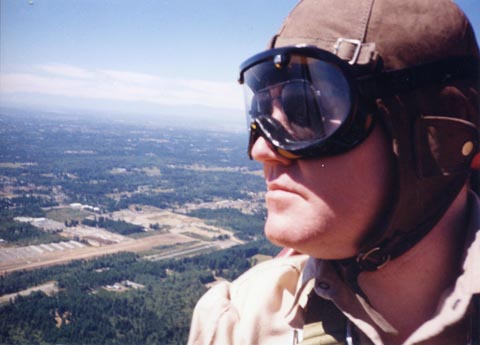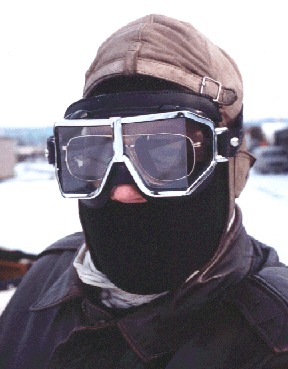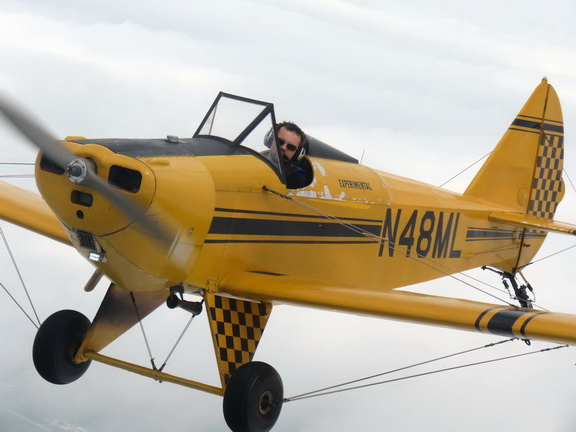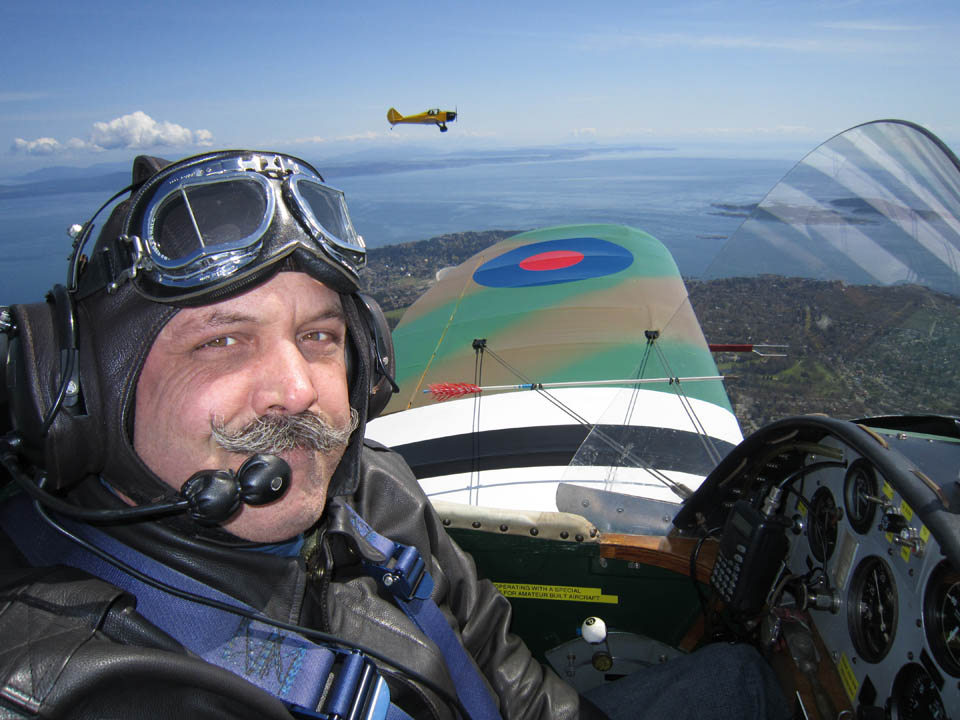Leather Flying Helmets
Sept 2014
Updated November 2022
Over the years, I've written about flying jackets, goggles, and
scarves...but until now, haven't touched on one of the fundamental
items of open-cockpit wear: The leather flying helmet.
There are a couple of reasons for that. The minor one is that
it's hard to talk about leather helmets without posting pictures of
them being worn, and you-know-who is the only available model.
The world is ugly enough without a bunch of "selfies" of me wearing
leather helmets. So there'll be a couple, below. Be
warned.
 The primary reason is that there aren't any "brands"
sold out there... without that, it's hard to give a
recommendation. About 90% of "leather flying helmets" are
meant to be joke items, and the real ones can be hard to find.
The term "Snoopy Helmet" is used quite a bit, usually by the
joke-helmet vendors, but not always.
The primary reason is that there aren't any "brands"
sold out there... without that, it's hard to give a
recommendation. About 90% of "leather flying helmets" are
meant to be joke items, and the real ones can be hard to find.
The term "Snoopy Helmet" is used quite a bit, usually by the
joke-helmet vendors, but not always.
The strange thing is, "joke helmets" aren't necessarily cheap
trash. Take a look at the older picture to the right (I did
warn you, didn't I). This was novelty helmet from Banana
Republic back when they first started, when they specialized in
unusual imported clothing. It worked quite nicely...it was the
only helmet I wore back when flying the no-radio N500F. I also
wore it for several years once I acquired my own Fly Baby, with a
radio.
What's the difference between a novelty item vs. what the
baseballers call a "Gamer"?
Mostly in adjustability and the resulting fit. Everybody's head is
shaped differently, and real helmets will include several straps and
buckles to adjust the helmet to fit your head better.
Do You Even Need a Helmet?
I prefer to wear a helmet primarily because of comfort. I wear
my hair pretty short, and don't like the way my hair "flutters" in
the drafts around the cockpit. Also, of course, on a colder
day, it keeps my noggin warm. There's an old Swiss saying: "If
your feet are cold, put on your hat." There are a lot of
blood vessels in your scalp (which is why minor head wounds bleed so
bad) and head coverings slow down the loss of heat. The helmet
also is a convenient place to attach your headset and goggles.
Not everyone does, of course. Some folks wear a baseball cap,
others don't bother with head covering at all. I admit, when
the temperature gets into the 90s, I'll leave the helmet off
myself. Here's Jesse Anglin....
Helmet Choices
There are basically four kinds of flying helmet:
- Cloth
- Leather with fabric lining
- Leather with fleece lining
- Hard helmets
 Cloth
helmets are cheaper, and cooler in hot weather. If you're in a
warmer clime, you might consider a cloth helmet for summer. I
find leather comfortable enough until the temperatures get in the
90s.
Cloth
helmets are cheaper, and cooler in hot weather. If you're in a
warmer clime, you might consider a cloth helmet for summer. I
find leather comfortable enough until the temperatures get in the
90s.
I've always used basic leather helmets. These come with a
fabric lining (nylon, silk, cloth, etc.) to help them slide on
easier.
You see leather helmets with fleece linings. Never had one, but they
are supposedly extremely warm, to the point where it's itchy.
It's the kind of thing a guy flying all day in winter might wear,
but for modern recreational flying, it's not necessary. In
cold weather, I wear a spandex ski mask under my regular helmet, and
there's no question that it's warm enough.
Finally, there are hard helmets like motorcycle helmets... the kind
military pilots wear. Some people prefer them due to the extra
protection.
Headset/Non-Headset models
Helmets come with and without headset accommodations, which consists
of big holes over the ears (for the headset ear cups) and a flap to
secure the helmet to the headset bow. I've flown both types in
varying circumstances... smooth-side helmet with no headset (NORDO
airplane), same helmet with a headset worn atop it (Most non-headset
helmets include side flaps with snaps that can be opened to improve
hearing), headset-accommodating helmet with a ANR headset, and a
smooth-side helmet with a homebuilt
low-profile ANR headset worn under it. Though the
smooth-side helmets *do* work with headsets... if you've got the
kind with the little flaps over the ears. It just doesn't give
you the best seal over the ears.
My recommendation would be a helmet with the accoutrements to
support a headset. With the top flap buckled and judicious use of
velcro dots, you can then treat the helmet and headset as one unit;
much easier to deal with. These holes are usually advertised
as fitting "David Clark" headsets. DCs are pretty big, so
other headsets should fit.
I stopped using the smooth-side helmet shown in the pictures when I
realized my ANR headset wasn't working to full ability when worn
over the helmet. My current one is a generic headset-type
helmet that fits my Flightcom Denali headset just fine. Here's
Drew Fidoe modelling his:
Features
I've talked about novelty helmets vs. "actual" helmets. The
difference is that a real helmet has certain features to make it
work better.
Adjustability is one. I have a rather square face, and have
trouble getting a helmet to fit around it (the old joke was that I
paid $5 for a haircut...$1 per side). An "actual" helmet might
include a strap across the forehead to help get the top to fit
closer to your head. And, it might include a similar strap
across the bottom back to help it fit tight at the nape of the neck.
Another aspect on adjustability is the chin strap. "One size fits
all" doesn't work, here, you need a strap that can adjust to
different lengths. I prefer buckles, either of the classic
type or the two-D-ring variety. Don't like snap-type straps,
myself...just gives you a couple of settings, and if you cinch it
type you have a heavy snap at the end of the strap hang free.
The helmet requires additional straps to support other
hardware. The goggle strap requires that the helmet include
either a vertical, fairly long strap in the back or two straps on
either side. The goggles tend to remain in place, but the
strap allows you to treat the helmet/goggle combination as a single
unit.
If you're going to try where a headset over a "smooth" helmet, make
sure it has ear openings. These are typically covered by
leather flaps held closed with snaps. Open the flaps, and make
sure the openings remain clear as the headset closes down. I
used to think these flaps are modern features to permit use with a
headset, but you see them way back into '20s. I think they
were an attempt to give a pilot better hearing when wearing his
helmet on the ground.
Finally, if you're wearing a headset over the helmet, you'd probably
like a flap or something that holds down the top bow of the
headset. I've got snaps on mine, and it works
fine. Strangely enough, though, sometimes the airstream
flutters the helmet a bit and I can hear the back of the snaps
"clack" against the headset bow.
Finding Them
Because of all the novelty headsets sold, one has to be a bit picky
when shopping for a helmet. Either order them from a vendor of
professional aviation items (such as Gibson and Barnes) or buy in
person at a shop where you can examine them and try them on.
I've never had to order a helmet, I've always lucked out and found
the right kinds for sale at local aviation stores or fly-ins.
I've never bought from them myself, but I hear a lot of good things
about Pop's Leather. They custom-build to your
measurements, surprisingly cheaply. They're in Turkey, but
apparently give quick international service. In the past, they've
had a booth in Oshkosh.
[Update 2022: Pop's Leather no longer has a web page, but is
apparently on Etsy. The above link is to their Etsy site.
Ron Wanttaja
 Return to the Stories Page
Return to the Stories Page

 The primary reason is that there aren't any "brands"
sold out there... without that, it's hard to give a
recommendation. About 90% of "leather flying helmets" are
meant to be joke items, and the real ones can be hard to find.
The term "Snoopy Helmet" is used quite a bit, usually by the
joke-helmet vendors, but not always.
The primary reason is that there aren't any "brands"
sold out there... without that, it's hard to give a
recommendation. About 90% of "leather flying helmets" are
meant to be joke items, and the real ones can be hard to find.
The term "Snoopy Helmet" is used quite a bit, usually by the
joke-helmet vendors, but not always.
 Cloth
helmets are cheaper, and cooler in hot weather. If you're in a
warmer clime, you might consider a cloth helmet for summer. I
find leather comfortable enough until the temperatures get in the
90s.
Cloth
helmets are cheaper, and cooler in hot weather. If you're in a
warmer clime, you might consider a cloth helmet for summer. I
find leather comfortable enough until the temperatures get in the
90s.
 Return to the Stories Page
Return to the Stories Page